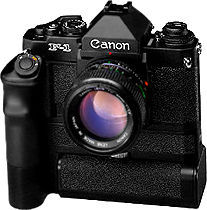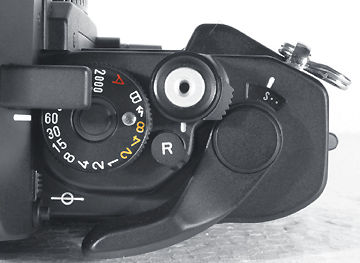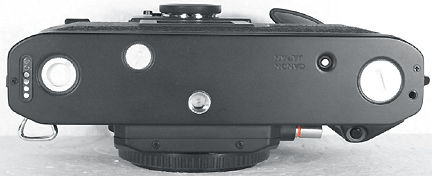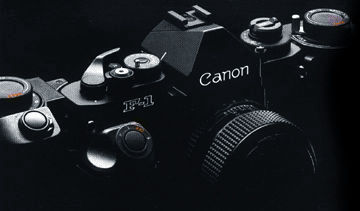The New F-l system is an advanced
and extensive one - it can only shown the difference when compared directly with
other equivalent system of other makes. Basically, to outline the system concept,
it is very straight forward: a die-cast body housing integrated units, complemented
by functional accessories.
|

|
In a system camera like the New F-1,
the body plays an extremely important role: it acts as the "command center"
for all external accessories, besides performing its own integral functions. Proper
design is thus an absolute must. Consequently, before arriving at the exact body
design.
|
Those days, one of the basic dilemmas
which SLR designers face concerns the strength of the camera body. The basic construction
of SLRs (a center mirror box surrounded by heavy parts on both sides) has the inherent
risk of insufficient strength. This weakness affects durability, and the more compact
and lightweight the camera, the more critical the problem. But it is a rare scenerio
to compared with modern all polycarbonate bodies, where platic injection rules the
manufacturing process to cut cost and make cameras lighter and in certain way, more
compact. Thus, the task of providing sufficient strength into the New F-1's diecast
body was entrusted to computers. Calculations were made to determine the weak points,
and dimensions were increased accordingly at the points requiring reinforcement.
|

|
These research could yield maximum
weight savings without compromising strength to a camera. It is interesting to note
from the top
panel of both the Old and New F-1.
All basic controls on the previous F-l were quite logically positioned. Since the
layout of these basic controls proved so successful, Canon was convinced that the
New F-1 should maintain this design.
Credit: Image courtesy
of Mr. Claudio®. who is a collector for Canon
photo gear, he also has an Ebay
Section
as well as maintaining a website
on his own
where occasionally trading some photo equipment. Image(s) copyright © 2003. All
rights reserved. Please respect the visual property of the contributing photographer.
|
Thus, the film advance lever (and
its stroke and stand-off angle), shutter speed dial, and shutter button, to name
a few, are positioned identically. This way, owners of both F-l models can use either
camera without having to make mental adjustments to a new, unfamiliar position.
While the basic controls of the
previous F-1 have been maintained, a number of body details have been modified in
the New F-1. In all cases, these vital or minor changes have been made based on data
gathered or friendly input over the past ten years from users of the F- 1. Of cause,
the first thing to note was more rounded corners and sides for better feel and grip
to reflect a modern feel, another was the battery cover is shaped into an action
grip, just like the A-1, perfectly fitting the right hand. The eyepiece ring is thinner
for easier viewing. A built-in eyepiece shutter eliminates the possibility of light
entering the eyepiece and affecting exposure during self-timed shots, long exposures,
and remote-control operations. A direct coupling contact accessory shoe has been
added to the EyeLevel
AE, and Speed Finders
for mounting Speedlites and the Wireless Controller LC-1, which was Nikon's F3 weakest
link. The film rewind button has been moved to the top of the camera and protected
by the film advance lever and the shutter release button, what is the advantage ?
Film rewinding and multiple exposures are possible with the camera mounted on a tripod.
For those who works heavily in flash photography, especially big handle flash unit,
measures have been taken to prevent electric shock when accidental contact is made
with the accessory shoe.
 |
Credit: Image courtesy
of Mr. Claudio®. who is a collector for Canon
photo gear, he also has an Ebay
Section
as well as maintaining a website
on his own
where occasionally trading some photo equipment. Image(s) copyright © 2003. All
rights reserved. Please respect the visual property of the contributing photographer.
|
Since film is affected by temperature,
humidity, and aging, it is very difficult to guarantee that it will lie in a flat
plane, to ensures that the film is held flat, the New F-1 has done that in its system
in two ways: 1 ) an extra-large film pressure plate and cartridge chamber helps maintain
flatness, and 2) by winding the film emulsion-side in. Moreover the camera back is
manufactured using plate steel for rigidity and durability. Internal reflections
in the mirror box tend to degrade image quality, particularly when using a wide angle
lens or photographing a backlit subject. Such internal reflections are a major cause
of flare. The New F-1 has a larger dimensions for the mirror box and by coating the
box's inside with a special anti-reflective paint to minimise the problem.
|
Back to Part I | Next -
Part III
|
Instruction
Manual:
Canon New F-1 Camera | Motor Drive FN | Canon High Speed Motor Drive Camera |
Main
Reference/Layout Map for body: HTML | PDF (471k)
Specifications: HTML | PDF (58k)
| Back to Main Index Page | Canon New F-1 Website
Its Concept, Its System
Metering Options, Viewfinders, Exposures Control, Reliability Issues,
Shutter Mechanism; Motor Drives/Winder, Data Film
backs,
Flash photography, Focusing Screens, Macro/Close-up,
Remote photography.
Canon FDn lenses.
| Early versions of FD lenses
| Message Board |
for your New Canon F-1 SLR camera(s)
| Message Board | for your Canon optics
in a shared environment
| Message Board | Specifically for Dispose or Looking for Canon Photographic
equipment

 |
Home -
Photography in Malaysia
|
About this photographic site.
Copyright
© 2000. leofoo ®. MIR Web Development Team.
Credit: Mr Richard Yeow, General
Manager of camera and video division, Canon
Marketing,
Malaysia and Tony Kano, for being so supportive and granting permission to
use some of the original content of Canon; Mr Philip Chong for
patching some mistakes made earlier in this site. Made with a PowerMac, Broadcating with
a RedHat Linux
Server.



